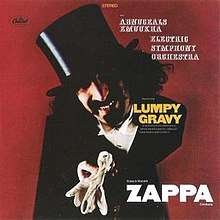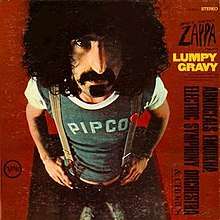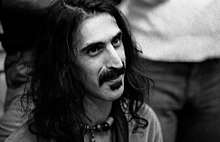Lumpy Gravy
Lumpy Gravy is the debut solo album by Frank Zappa, written by Zappa and performed by a group of session players he dubbed the Abnuceals Emuukha Electric Symphony Orchestra. Zappa conducted the orchestra but did not perform on the album. It is his third album overall: his previous releases had been under the name of his group, the Mothers of Invention.
| Lumpy Gravy | ||||
|---|---|---|---|---|
 Original LP cover | ||||
| Studio album by | ||||
| Released | August 7, 1967 (original) May 13, 1968 (official) | |||
| Recorded | February 1967 | |||
| Genre | Jazz fusion, modern classical, sound collage | |||
| Length | 22:37 (original) 31:45 (official) | |||
| Label | Capitol | |||
| Producer | Nick Venet | |||
| Frank Zappa chronology | ||||
| ||||
| Frank Zappa solo chronology | ||||
| ||||
| 1968 reissue cover | ||||
 | ||||
It was commissioned and briefly released, on August 7, 1967, by Capitol Records in the 4-track Stereo-Pak format only and then withdrawn due to a lawsuit from MGM Records. MGM claimed that the album violated Zappa's contract with their subsidiary, Verve Records. In 1968 it was reedited and released by MGM's Verve Records on May 13, 1968. The final version of the album consisted of two musique concrète pieces that combined elements from the original orchestral performance with elements of surf music and the spoken word. It was praised for its music and editing.
Produced simultaneously with We're Only in It for the Money, Zappa saw Lumpy Gravy as the second part of a conceptual continuity that later included his final album, Civilization Phaze III.
Recording

Following the release of Freak Out!, the debut album of the rock band the Mothers of Invention, Capitol Records A&R representative Nick Venet commissioned an album of orchestral music composed by the Mothers of Invention's leader, Frank Zappa, a self-taught composer. Venet spent $40,000 on the album.[1][2] Because Zappa's contract with Verve and MGM Records did not allow for him to perform on albums recorded for any other label, he could not play any instrument on the proposed album, and instead served as the conductor of an orchestra consisting of session musicians hired for the recording. Zappa stated that "my contract [with MGM] did not preclude me from doing that. I wasn't signed as a conductor."[1]
Lumpy Gravy was conceived as a short oratorio, written in eleven days.[2] Zappa named the group assembled for the sessions the "Abnuceals Emuukha Electric Symphony Orchestra".[2]
Percussionist Emil Richards recalled that he did not know who Zappa was and did not take him seriously as the recording sessions began, believing that Zappa was merely the guitarist for a rock band. However, upon meeting them, Zappa handed the musicians the scores for the pieces, which were dense, complex and varied in time signatures.[1] Richards' close friend, guitarist Tommy Tedesco, was another member of the recording sessions. Tedesco mocked Zappa, believing that Zappa did not know what he was doing.[1] The bassoonist and bass clarinetist hired for the sessions refused to perform their parts, declaring them impossible to play. Zappa responded, "If I play your part, will you at least try it?" Zappa then played on his guitar the notes for the musicians, who agreed to perform their assigned parts.[1] By the end of the recording sessions, Richards and Tedesco became convinced of Zappa's talent, and became friends with the composer. Richards later performed on sessions which appeared on Zappa's album Orchestral Favorites.[1]
Release, lawsuit and reediting
Capitol released Lumpy Gravy on August 7, 1967, only on the 4-track cartridge format, apparently in limited numbers. This version of the album is markedly different from the Lumpy Gravy that would become an official entry in Zappa's catalog. Capitol also intended to release a single consisting of the pieces "Gypsy Airs" and "Sink Trap" to promote its release.[2] In response to the album's release, MGM threatened a lawsuit, claiming that its release violated Zappa's contract.[2]
During the litigation, Zappa expanded and significantly edited the album, adding spoken word and musique concrète interludes, as well as some pieces of music from his pre-Mothers archives. The original Lumpy Gravy was not re-released until 2008, with the Zappa Records triple-CD release, The Lumpy Money Project/Object.
The dialogue segments were recorded at Apostolic Studios in New York City after Zappa discovered that the strings of the studio's grand piano would resonate if a person spoke near those strings. The "piano people" experiment involved Zappa having various speakers improvise dialogue using topics offered by Zappa. Most of the dialogue on the reedited Lumpy Gravy, recorded simultaneously with We're Only in It for the Money,[3] was spoken by a small group which included Motorhead Sherwood, Roy Estrada, Spider Barbour, All-Night John (the manager of the studio) and Louis Cuneo, who was noted for his laugh, which sounded like a "psychotic turkey".[2] The concept of the reedited album derived from Zappa's "big note" theory, which states that the universe consists of a single element, and that atoms are vibrations of that element, a "big note".[4]
The revised album proved to be very difficult to make, as the orchestral master tapes recovered from Capitol featured many poor splices.[4] The reedited version also incorporated additional musical content not on the original release of the album, including previously recorded surf music[4] and a 1963 Zappa-produced demo recording of a tune that later appeared in a 1967 recording under the title "Take Your Clothes Off When You Dance" on We're Only in It for the Money. Some of the editing was done in Zappa's living room.[5] On the 1967 and 1968 releases of the album, Zappa was credited as "Francis Vincent Zappa", as Zappa had believed that this was his real name. He later learned that his birth name was Frank Vincent Zappa, and this mistake was subsequently corrected in reissues of the album.[5]
Reception and legacy
| Review scores | |
|---|---|
| Source | Rating |
| Allmusic | |
| Rolling Stone | (negative) [7] |
| Uncut | 7/10 [8] |
The reedited Lumpy Gravy was well received by critics, and Zappa called it one of his favorite albums out of his own work, stating that it contains his favorite music.[9] Allmusic writer François Couture wrote, "The starting point of Zappa's 'serious music,' Lumpy Gravy suffers from a lack of coherence, but it remains historically important and contains many conceptual continuity clues for the fan."[6]
In 1984, the second version of Lumpy Gravy was remixed by Zappa, with new overdubs by bassist Arthur Barrow and drummer Chad Wackerman.[1] This third version of the album was not released in full at the time; an excerpt appeared in a The Old Masters sampler sent to radio stations.[10] Dialogue from the "piano people" sessions was included on Zappa's later album Frank Zappa Meets the Mothers of Prevention,[11] and his final album, Civilization Phaze III in 1993.[12] In 2009, the box set Lumpy Money was released, containing the 1967 and 1984 versions of Lumpy Gravy, and audio documentary material derived from the sessions that produced the original 1967 orchestral sessions, dialogue which appeared in the 1968 release of Lumpy Gravy, and the album We're Only in It for the Money.[13] On April 18, 2018, the original 1967 edit of the album was released on limited edition vinyl as a Record Store Day exclusive under the title Lumpy Gravy (Primordial).[14]
Zappa remastered the album in 1985 and again in 1993.
Track listing
All tracks are written by Frank Zappa.
| No. | Title | Length |
|---|---|---|
| 1. | "Sink Trap" | 2:45 |
| 2. | "Gum Joy" | 3:44 |
| 3. | "Up and Down" | 1:52 |
| 4. | "Local Butcher" | 2:36 |
| 5. | "Gypsy Airs" | 1:41 |
| 6. | "Hunchy Punchy" | 2:06 |
| 7. | "Foamy Soaky" | 2:34 |
| 8. | "Let's Eat Out" | 1:49 |
| 9. | "Teenage Grand Finale" | 3:30 |
| Total length: | 22:37 | |
| No. | Title | Length |
|---|---|---|
| 1. | "The Way I See It, Barry" | 0:06 |
| 2. | "Duodenum" | 1:32 |
| 3. | "Oh No" | 2:03 |
| 4. | "Bit of Nostalgia" | 1:35 |
| 5. | "It's from Kansas" | 0:30 |
| 6. | "Bored Out 90 Over" | 0:31 |
| 7. | "Almost Chinese" | 0:25 |
| 8. | "Switching Girls" | 0:29 |
| 9. | "Oh No Again" | 1:13 |
| 10. | "At the Gas Station" | 2:41 |
| 11. | "Another Pickup" | 0:54 |
| 12. | "I Don't Know If I Can Go Through This Again" | 3:49 |
| Total length: | 15:50 | |
| No. | Title | Length |
|---|---|---|
| 1. | "Very Distraughtening" | 1:33 |
| 2. | "White Ugliness" | 2:22 |
| 3. | "Amen" | 1:33 |
| 4. | "Just One More Time" | 0:58 |
| 5. | "A Vicious Circle" | 1:12 |
| 6. | "King Kong" | 0:43 |
| 7. | "Drums Are Too Noisy" | 0:58 |
| 8. | "Kangaroos" | 0:57 |
| 9. | "Envelops the Bath Tub" | 3:42 |
| 10. | "Take Your Clothes Off" | 1:53 |
| Total length: | 15:56 | |
Personnel
- Musicians - Abnuceals Emuukha Electric Symphony Orchestra
|
|
|
- Production credits
- Frank Zappa - composer, conductor
- Cal Schenkel - artwork
Charts
Album - Billboard (United States)
| Year | Chart | Position |
|---|---|---|
| 1968 | Billboard 200 | 159 |
References
- Fricke, David (2008). Lumpy Money (Media notes). Frank Zappa. Zappa Records.
- Slaven, Neil (2009-11-17). Electric Don Quixote: The Definitive Story Of Frank Zappa. Music Sales Group. ISBN 9780857120434. Retrieved August 20, 2012.
- Schinder, Scott (2008). Icons of Rock. Greenwood Publishing Group. p. 363. ISBN 9780313338472. Retrieved August 20, 2012.
- Walley, David (22 Aug 1996). No Commercial Potential: The Saga of Frank Zappa. Da Capo Press. p. 240. ISBN 0306807106. Retrieved August 20, 2012.
- Zappa, Frank with Occhiogrosso, Peter (1989). The Real Frank Zappa Book. New York: Poseidon Press. pp. 244–245. ISBN 0-671-63870-X.
- Lumpy Gravy at AllMusic
- Miller, Jim (June 22, 1968). "Lumpy Gravy - Album Reviews - Rolling Stone". Rolling Stone. Retrieved 12 July 2013.
- Cavanagh, David (14 September 2016). "Frank Zappa/The Mothers of Invention reissues". Retrieved 25 December 2016.
- Kart, Larry (11 Oct 2004). Jazz in Search of Itself. Yale University Press. p. 166. ISBN 0300128193. Retrieved August 20, 2012.
- Zappa, Gail (2008). "track listing notes". Lumpy Money (Media notes). Frank Zappa. Zappa Records.
- Rense, Rip (Jan 1986). "Flash - Mothers of Prevention". Spin. SPIN Media LLC. 1 (9): 82. Retrieved 20 August 2012.
- Morin, Alexander J. (2002). Classical Music: The Listener's Companion. Backbeat Books. p. 1067. ISBN 9780879306380. Retrieved August 20, 2012.
- Dolan, Casey (December 8, 2008), "The Resurrection of Frank Zappa's Soul", LA Weekly, Village Voice Media
- ""Lumpy Gravy Primordial" Vinyl Pressing - Record Store Day 2018". 2018-03-06.